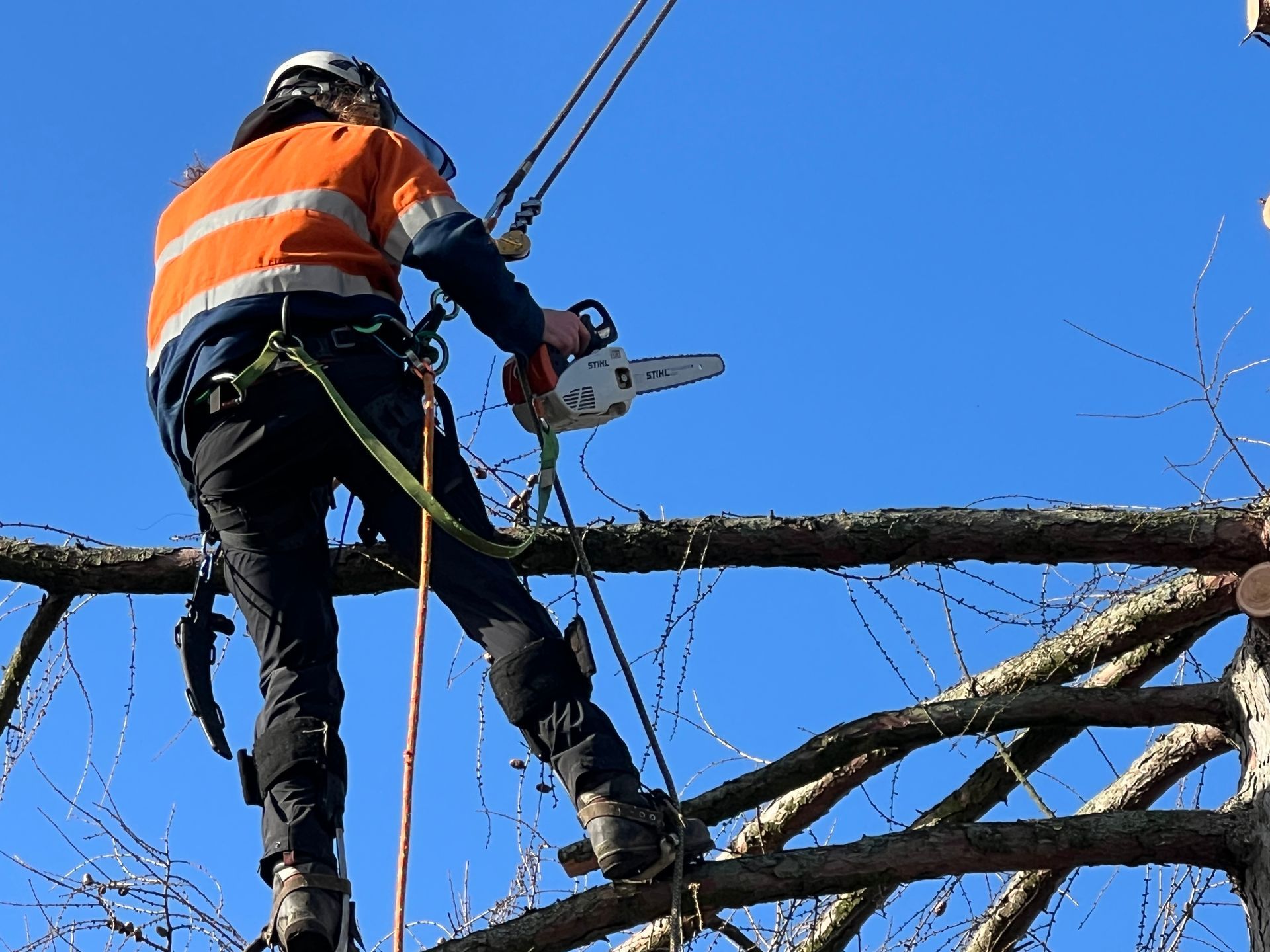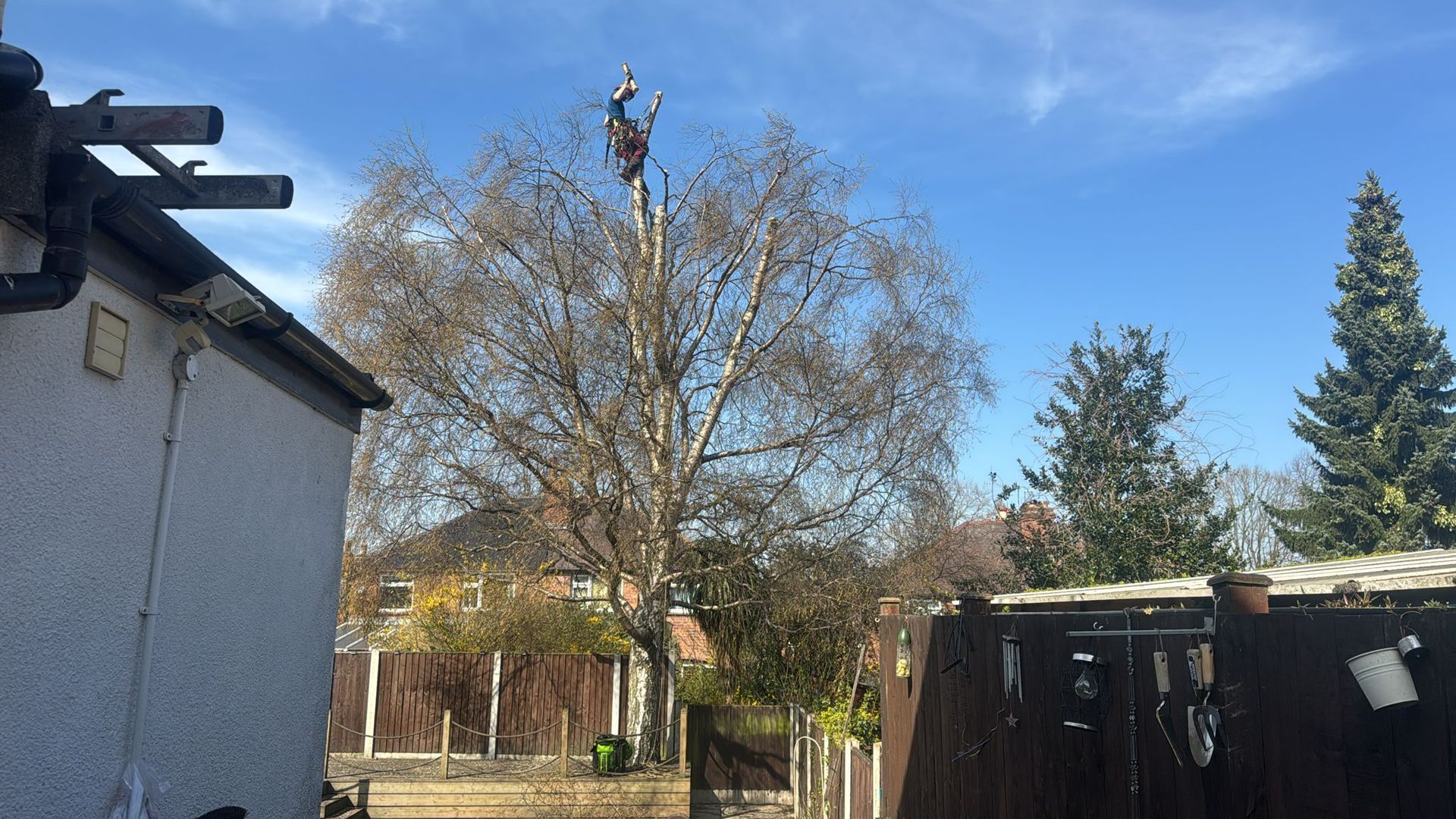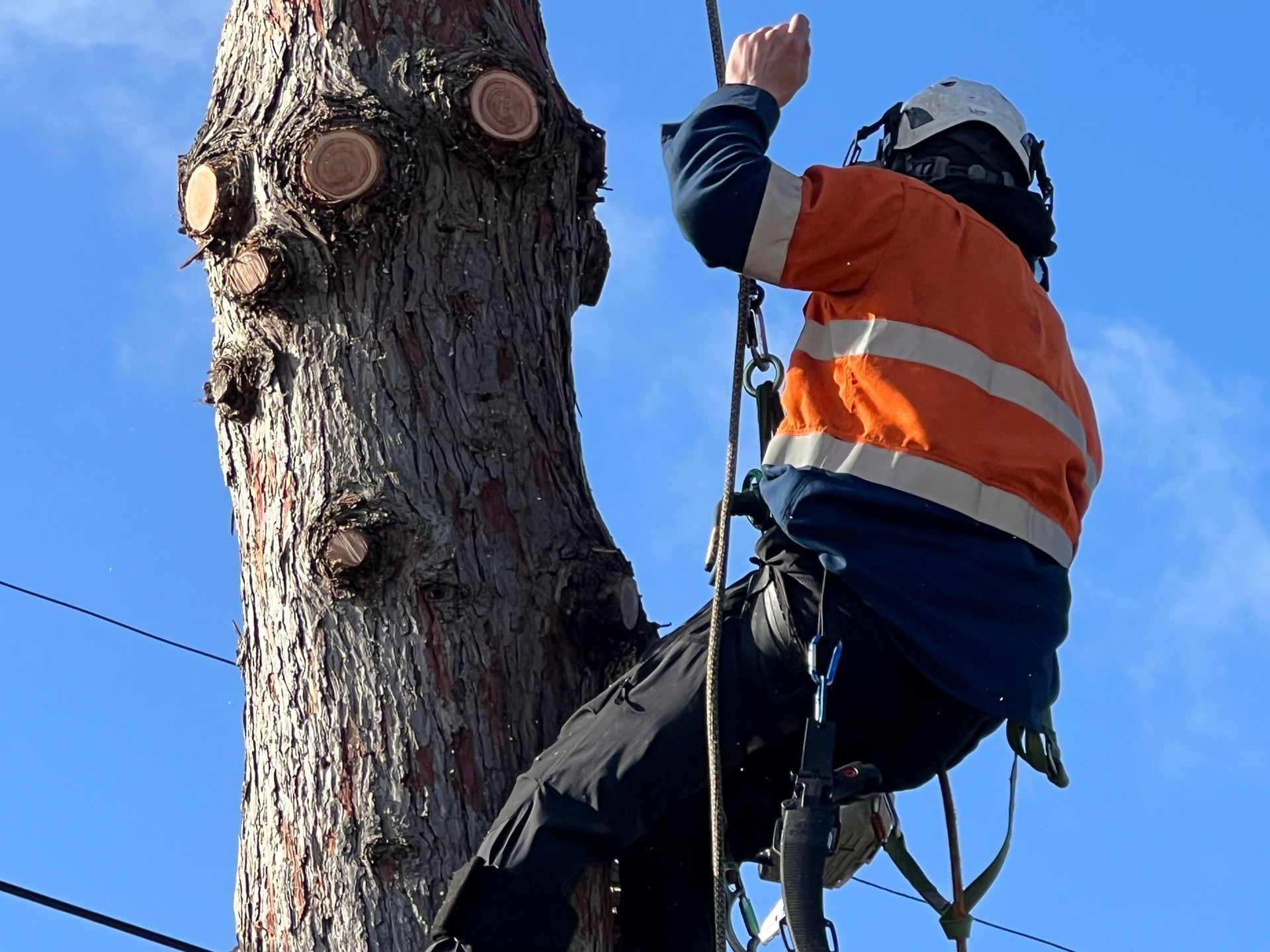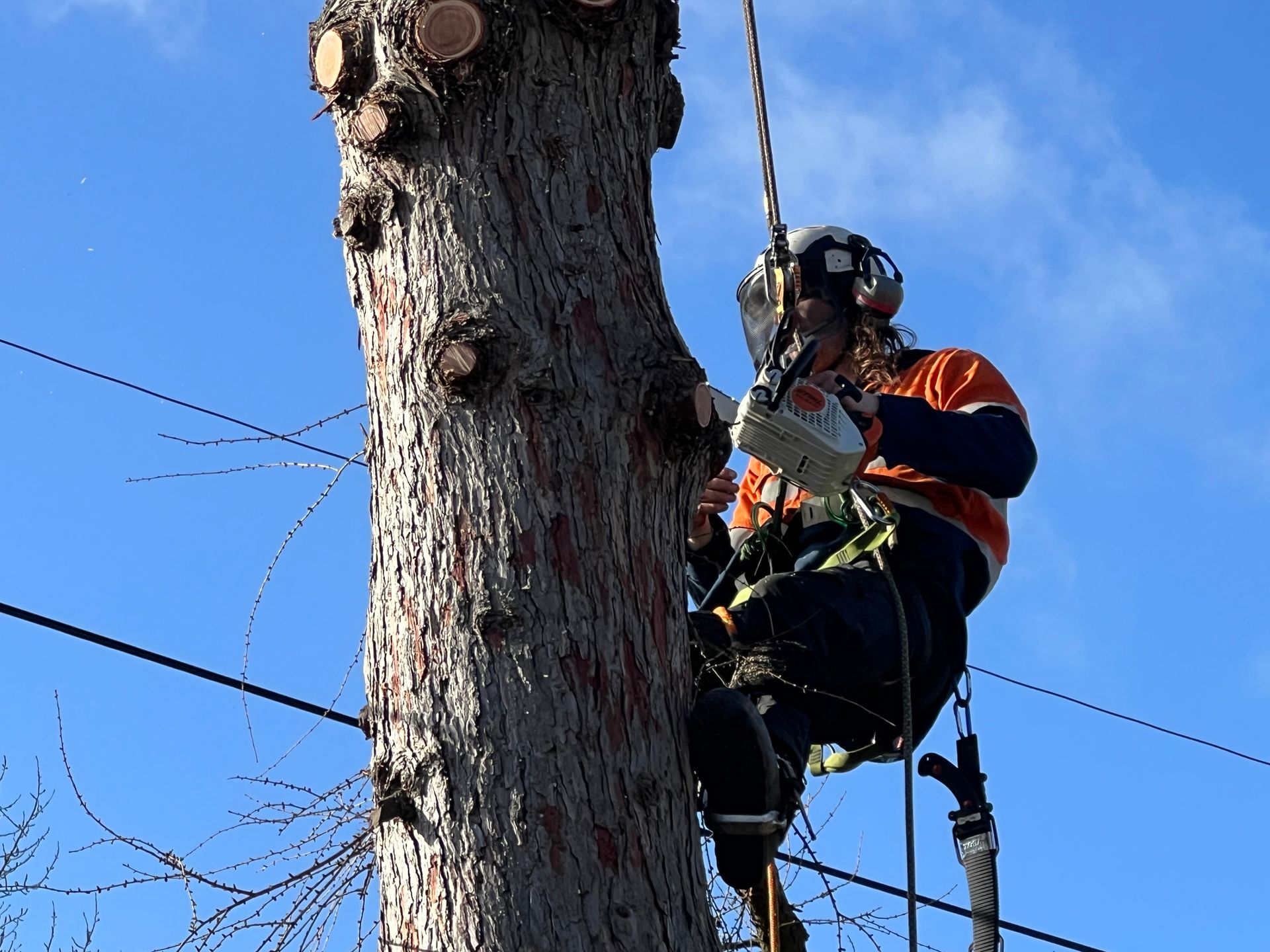0115-647-0351
Looking for expert fruit tree care in Nottingham? You've come to the right place. At Nottingham Tree Surgery and Arborist Services, we specialise in professional fruit tree surgery that keeps your trees healthy, productive, and safe. Whether you need apple tree pruning for better harvests or comprehensive pear tree surgery to tackle disease issues, our certified arborists have the local expertise you need.
Why Proper Fruit Tree Pruning Matters for Nottingham Gardens
The Science Behind Effective Fruit Tree Pruning
Getting your fruit trees properly pruned isn't just about keeping them tidy – it's about understanding how trees work and what they need to thrive. When we carry out professional fruit tree surgery, we're working with nature's own systems to encourage healthy growth and abundant fruit production.
Proper pruning improves air circulation through the canopy, which is absolutely crucial for preventing fungal diseases that thrive in Nottingham's often damp conditions. By removing crossing branches and opening up the centre of the tree, we create an environment where each leaf gets adequate sunlight and air can move freely. This means healthier trees and better-quality fruit that actually tastes as good as it should.
The timing and technique of cuts also matter enormously. When we make pruning cuts, we're essentially directing the tree's energy. Remove a branch in winter, and you'll get vigorous spring growth. Make the same cut in summer, and you'll reduce the tree's vigour whilst improving fruit quality. It's all about knowing when and how to make these strategic decisions.
Nottingham's Climate and Fruit Tree Challenges
Living in the East Midlands presents unique challenges for fruit tree care that many generic gardening guides simply don't address. Our climate here is what we'd call 'changeable' – mild winters followed by unpredictable springs, and summers that can swing from drought to deluge sometimes within the same week.
This variability means timing your apple tree pruning becomes even more critical. We've learned from 15 years of local experience that waiting too long into spring can leave trees vulnerable to late frosts that damage new growth. Similarly, our relatively high rainfall means fungal diseases like apple scab and pear rust are constant threats that proper pruning can help prevent.
The clay-heavy soils common around Nottingham also affect how trees respond to pruning. Trees growing in our local conditions often need more careful management of their root-to-canopy ratio, which is why we tailor our pear tree surgery techniques to account for these specific growing conditions.
What Happens When Fruit Trees Aren't Properly Maintained
We've seen too many beautiful fruit trees decline because they haven't received proper care. Unpruned trees quickly become overcrowded, with branches competing for light and air. The result? Smaller, poorer quality fruit and trees that become increasingly susceptible to disease and pest problems.
Without regular fruit tree surgery, you'll also face safety issues. Heavy branches laden with fruit can snap without warning, potentially causing damage to property or injury to people. We've been called out to many emergency situations that could have been prevented with proper maintenance.
The economic impact is significant too. A well-maintained apple tree can produce fruit for decades, providing both fresh produce for your family and adding value to your property. Neglected trees often need complete removal and replacement – a much more expensive proposition than regular maintenance.
Our Expert Fruit Tree Pruning Process
Initial Assessment and Tree Health Evaluation
Every job begins with a thorough assessment because no two trees are exactly alike. Our certified arborists examine each tree individually, looking at its overall health, structure, and specific needs. We check for signs of disease, pest damage, and structural weaknesses that might affect our pruning strategy.
During this assessment, we identify the tree species and variety, which is crucial for determining the best pruning approach. Different apple varieties, for instance, fruit on different types of wood – some on spurs, others on the tips of young shoots. Getting this wrong can significantly reduce your harvest.
We also evaluate the tree's age and maturity level. Young trees need formative pruning to establish good structure, whilst mature trees require maintenance pruning to keep them productive and healthy. Older trees might need renovation pruning to rejuvenate them and extend their productive life.
Customised Pruning Plans for Different Fruit Tree Types
Apple Tree Pruning Techniques
Apple trees are perhaps the most common fruit trees in Nottingham gardens, and they respond beautifully to proper care. Our apple tree pruning approach depends on the tree's age, variety, and intended use. For eating apples, we focus on maximising fruit quality, whilst cooking apple trees can handle heavier cropping with slightly different pruning strategies.
We use two main training systems for apple trees. The open-centre method creates a goblet shape that allows excellent light penetration and air circulation – perfect for our climate. The modified central leader system maintains a main trunk with well-spaced lateral branches, which works well for vigorous varieties or where space is limited.
Timing is everything with apple tree pruning. We typically prune during the dormant season (December through February) when the tree's energy is focused in the roots. However, some summer pruning in July and August can help control vigour and improve fruit quality, particularly for dessert apple varieties.
Pear Tree Specialised Care
Pear trees require a different approach from apples, and our pear tree surgery techniques reflect this. Pears are naturally more upright growers and tend to be more susceptible to fire blight, a bacterial disease that can quickly kill branches or entire trees.
We train pear trees using a central leader system, maintaining a strong main trunk with horizontal branches. This not only gives the best fruit production but also creates the strongest structure to support heavy crops. Pears can be incredibly productive when properly managed.
Fire blight prevention is a key part of our pear tree surgery. We make all cuts during dry weather and immediately treat wounds with appropriate sealers. We also maintain good air circulation through proper spacing of branches and remove any showing signs of bacterial infection.
Stone Fruit Pruning (Plums, Cherries, Peaches)
Stone fruits need careful handling because they're susceptible to silver leaf disease, which enters through fresh cuts. We always prune stone fruits during their active growing season (late spring through early autumn) when they can quickly heal wounds and resist infection.
Plum trees benefit from annual pruning to prevent overcrowding and maintain good shape. We remove dead, diseased, or crossing branches and thin out areas where growth is too dense. Cherry trees, particularly sweet cherries, need minimal pruning once established, though we do remove water shoots and maintain overall shape.
For the few peach trees brave enough to grow in our climate, we use a slightly different approach, focusing on renewal pruning to encourage new fruiting wood whilst maintaining the tree's size and shape.
Professional Tools and Safety Standards
We use only professional-grade equipment that's properly maintained and sterilised between trees. Our pruning tools are sharp and clean, ensuring smooth cuts that heal quickly and don't provide entry points for disease.
Safety is paramount in all our work. Our team is fully insured and trained to current industry standards. We follow proper procedures for working at height and ensure that all debris is safely cleared away. Every job site is left clean and tidy.
Optimal Timing for Fruit Tree Pruning in Nottingham
Winter Pruning Schedule (November-March)
Winter is the traditional time for major fruit tree surgery, and for good reason. Trees are dormant, making it easier to see their structure without leaves obscuring the view. It's also when trees are least likely to suffer stress from pruning.
In Nottingham, we typically begin winter pruning in December once the leaves have fallen and continue through to February. We avoid pruning during severe frost periods, as this can damage freshly cut wood. The exact timing varies slightly depending on the species and variety we're working with.
Winter pruning promotes vigorous spring growth, which is exactly what we want for young trees that need to establish good structure. For mature trees, winter pruning helps maintain size and shape whilst encouraging strong fruiting wood development.
Summer Pruning Benefits (June-August)
Summer pruning might seem counterintuitive, but it's an incredibly valuable technique for managing fruit trees. Light summer pruning reduces the tree's vigour, which can actually improve fruit quality by concentrating the tree's energy into fewer, better-quality fruits.
We use summer pruning particularly for apple trees where we want to control size and improve fruit colour and flavour. By removing some of the leaf area, we allow more light to reach the developing fruits, improving their colour and sugar content.
Summer pruning also helps us identify and remove water shoots – those vigorous vertical shoots that contribute nothing to fruit production but consume energy that could be better used elsewhere.
Emergency Pruning Services
Sometimes pruning can't wait for the ideal season. Storm damage, disease outbreaks, or safety hazards require immediate attention. We provide emergency fruit tree surgery services throughout the year, using techniques that minimise stress on the tree whilst addressing immediate concerns.
Emergency pruning often involves removing damaged or dangerous branches whilst leaving the major structural work for a more appropriate time. We assess each situation individually and provide advice on immediate needs versus longer-term tree care.
The Long-Term Benefits of Professional Fruit Tree Care
Increased Fruit Production and Quality
Proper fruit tree surgery doesn't just maintain your trees – it actively improves their performance. Well-pruned trees typically produce 30-50% more fruit than unpruned ones, and the quality difference is even more dramatic.
When we thin overcrowded branches, we're essentially doing the tree's job for it. Instead of producing lots of small, poor-quality fruits, the tree can focus its energy on fewer, larger, better-flavoured ones. This is particularly important for apple tree pruning, where proper thinning can mean the difference between a bumper crop of supermarket-quality apples and a moderate harvest of prize-winning fruit.
Regular pruning also extends the productive life of fruit trees. Trees that receive proper care can continue producing high-quality fruit for decades longer than neglected ones. This represents excellent value for money over the long term.
Tree Longevity and Health
Fruit tree surgery isn't just about this year's crop – it's an investment in your tree's future. By removing diseased or damaged wood promptly, we prevent problems from spreading and becoming more serious. Regular pruning also improves the tree's structure, making it more resistant to wind damage and heavy crop loads.
Proper pruning techniques ensure that cuts heal quickly and cleanly, reducing the risk of pest and disease problems. We make all cuts at the correct angle and position to promote rapid healing and prevent water from collecting on cut surfaces.
Well-maintained trees are also more resilient to environmental stresses like drought, extreme temperatures, and pest outbreaks. The improved air circulation and light penetration that comes from proper pruning creates conditions that favour tree health over pest and disease problems.
Property Value Enhancement
Mature, well-maintained fruit trees are a genuine asset to any property. They provide not just fruit but also aesthetic value, wildlife habitat, and a sense of established gardens that can't be achieved overnight.
Property surveys often note the condition of mature trees, and well-maintained specimens can add significant value to a property. Conversely, neglected or dangerous trees can be seen as liabilities that require expensive attention.
From an insurance perspective, properly maintained trees are much less likely to cause damage during storms. Regular professional inspection and maintenance can also help demonstrate that you're taking reasonable care of potential hazards on your property.
Why Choose Nottingham Tree Surgery for Your Fruit Trees
Local Expertise and Knowledge
We've been providing fruit tree surgery services in Nottingham and the surrounding areas for over 15 years. This local experience means we understand the specific challenges that fruit trees face in our area – from the clay soils of West Bridgford to the more exposed conditions around Beeston.
Our knowledge of local conditions extends to understanding which fruit varieties perform best in our climate and soil conditions. We can advise not just on caring for existing trees but also on what to plant if you're establishing a new orchard or replacing old trees.
We also understand the local regulatory environment. Nottingham City Council and surrounding authorities have specific requirements about tree work, particularly for trees in conservation areas or those subject to Tree Preservation Orders. We handle all necessary permissions and ensure compliance with local regulations.
Qualified Arborists and Certifications
Our team holds current NPTC certifications in all aspects of tree surgery and arboriculture. We're also members of the International Society of Arboriculture, which means we stay current with the latest research and best practices in tree care.
Continuing education is important in our field because understanding of tree biology and care techniques continues to evolve. We regularly attend training courses and industry conferences to ensure we're providing the most up-to-date and effective care for your trees.
All our staff are trained in health and safety procedures and hold current first aid certificates. We maintain comprehensive insurance coverage and operate to current industry safety standards.
Comprehensive Insurance and Guarantees
We carry full public liability insurance and employer's liability insurance, giving you complete peace of mind when we're working on your property. Our insurance covers not just our work but also any accidental damage that might occur during the course of our operations.
We stand behind our work with clear guarantees on the quality of our fruit tree surgery. If you're not satisfied with our work, we'll return to address any concerns at no additional charge. We also provide follow-up advice and are available to answer questions about tree care long after the work is completed.
Getting Started: Book Your Fruit Tree Assessment in Nottingham Today!
Ready to give your fruit trees the care they deserve? Getting started is straightforward. We begin every relationship with a free, no-obligation consultation where we assess your trees and discuss your goals and concerns.
During this initial visit, we'll evaluate each tree's health and condition, identify any immediate problems, and provide a detailed written quote for recommended work. We explain our recommendations clearly and answer any questions you might have about the proposed work.
To book your free consultation, simply call us on [phone number] or use our online booking system. We typically schedule consultations within a few days of your call and can often accommodate urgent requests the same day.
Our fruit tree surgery services cover Nottingham city centre, West Bridgford, Beeston, Long Eaton, and all surrounding villages. We're proud to be Nottingham's trusted choice for professional fruit tree care, combining local expertise with the highest standards of workmanship and customer service.
Don't let another season pass with underperforming fruit trees. Professional apple tree pruning and pear tree surgery can transform your harvest and ensure your trees remain healthy and productive for years to come.
Contact us today to discover what proper fruit tree care can do for your garden.
Frequently Asked Questions About Fruit Tree Pruning & Trimming
1. When is the best time to prune my fruit trees in Nottingham?
The optimal time for fruit tree surgery in Nottingham is during the dormant season, typically from December through February. This timing works perfectly with our local climate because the trees have shed their leaves, making it easier to see the structure and identify which branches need attention.
However, the timing does vary slightly depending on the type of fruit tree you have. For apple tree pruning and pear tree surgery, winter is ideal because these trees are less susceptible to disease when pruned during dormancy. Stone fruits like plums and cherries are different though – they're best pruned in late spring or early summer to avoid silver leaf disease, which can be a real problem in our damp Nottinghamshire climate.
We always avoid pruning during severe frost periods or when the weather's particularly wet, as this can stress the trees or increase disease risk. If you're unsure about timing for your specific trees, our team can advise you based on the varieties you have and current weather conditions.
2. How much should I expect to pay for professional fruit tree pruning in Nottingham?
Professional fruit tree pruning costs in Nottingham typically range from £100-£150 for small to medium trees, whilst larger, more complex trees can cost £250-£600 depending on the work involved. The price depends on several factors: the size and type of tree, how much work is needed, accessibility, and whether any diseased wood needs careful removal.
For multiple trees, many customers find our seasonal maintenance contracts offer better value. These annual arrangements include regular apple tree pruning and pear tree surgery at discounted rates, plus priority booking during busy periods. We also offer package deals for small orchards (2-5 trees) that work out more economical than individual tree pricing.
What's included in our pricing is comprehensive – we provide a detailed assessment, professional pruning using proper techniques, cleanup of all debris, and follow-up advice. Unlike some companies, we don't charge extra for basic cleanup or disposal of small amounts of pruning waste. For larger jobs requiring special equipment or difficult access, we'll always discuss any additional costs upfront so there are no surprises.
3. Can I prune my own fruit trees, or should I hire professionals?
You can certainly handle basic maintenance on smaller fruit trees – things like removing obvious dead wood, water shoots, or light thinning of overcrowded areas. Many of our customers enjoy doing some of the simpler work themselves as part of their regular garden maintenance.
However, there are several situations where professional fruit tree surgery really makes sense. If your trees are tall enough to require a ladder, if you're dealing with diseased wood that needs proper disposal, or if you're unsure about which branches to remove, it's worth getting expert help. Incorrect cuts can actually harm the tree's health and reduce fruit production for years to come.
The biggest risk with DIY apple tree pruning is making cuts at the wrong time or in the wrong place. Each cut affects how the tree will grow and fruit in following seasons. We've seen many cases where well-meaning homeowners have accidentally removed fruiting spurs or made cuts that encourage excessive vegetative growth at the expense of fruit production. Professional training helps us make strategic decisions that benefit the tree long-term.
4. How often do my fruit trees need pruning?
Most fruit trees benefit from annual attention, though the extent of work needed varies considerably. Young trees (under 5 years) typically need more formative pruning to establish good structure, whilst mature trees might only need maintenance pruning every 2-3 years.
Apple trees generally need annual winter pruning to maintain their shape and encourage good fruiting wood development. Pear tree surgery follows a similar schedule, though pears often need less intensive work once they're well-established. Stone fruits like plums typically need lighter, more frequent attention – often just summer pruning to remove water shoots and maintain shape.
The key is regular assessment rather than rigid scheduling. We recommend having your trees evaluated annually, even if they don't need major work. Sometimes just removing a few water shoots or thinning overcrowded areas can make a big difference to next season's crop. It's much easier and less expensive to maintain trees with regular light pruning than to tackle overgrown trees that need major renovation work.
5. What's the difference between pruning and trimming?
This is a great question because many people use these terms interchangeably, but they're actually quite different approaches with different goals.
Pruning is the strategic removal of branches to improve tree health, structure, and fruit production. When we do apple tree pruning, we're making careful decisions about which branches to remove based on how the tree grows and fruits. This might involve removing diseased wood, thinning crowded areas to improve air circulation, or shortening branches to encourage fruiting spur development.
Trimming, on the other hand, is more about maintaining size and appearance. It's typically lighter work focused on keeping trees neat and preventing them from getting too large or encroaching on buildings, paths, or neighbouring properties.
In fruit tree surgery, we're primarily doing pruning work because the goal is optimising the tree's health and productivity, not just its appearance. However, many jobs involve elements of both – we might prune for health and structure whilst also trimming to keep the tree at a manageable size for harvesting.
6. Will pruning reduce the amount of fruit my trees produce?
This is one of the biggest concerns we hear from customers, and it's understandable because you are removing branches that could potentially bear fruit. However, proper fruit tree surgery actually improves both the quantity and quality of your harvest in most cases.
When we do professional apple tree pruning, we're essentially helping the tree focus its energy on producing fewer, but much better quality fruits. Unpruned trees often produce lots of small, poor-quality fruit because they're trying to support too many developing fruits with limited resources. By strategic pruning, we reduce the total number of fruits but increase their size, flavour, and storage quality.
The technique also improves light penetration and air circulation through the canopy, which helps prevent diseases and ensures that remaining fruits develop properly. Most customers find that whilst they might have slightly fewer fruits after proper pruning, the ones they do get are much more satisfying to eat and the tree remains healthier long-term.
There can be a temporary reduction in the first year after heavy pruning, particularly if the tree was previously neglected. However, the improved structure and health typically result in better crops in subsequent years.
7. My fruit tree hasn't been pruned for years – is it too late to start?
It's rarely too late to start proper care for neglected fruit trees, though the approach needs to be more gradual than with regularly maintained trees. We see many overgrown trees that have been ignored for years, and with patient work, most can be restored to good health and productivity.
The key with renovation pruning is spreading the work over 2-3 years rather than trying to do everything at once. Removing more than about 25% of the canopy in one go can shock the tree and actually encourage excessive water shoot growth. We typically start by removing dead, diseased, or obviously problematic wood in the first year, then gradually open up the canopy and reduce height over subsequent seasons.
Pear tree surgery often works particularly well for renovation because pears tend to respond positively to gradual reduction. Apple trees can also be successfully renovated, though very old trees might take longer to respond.
The main consideration is whether the tree is worth renovating compared to replacing it. If the trunk is sound and there's no major disease, renovation is usually worthwhile. Our assessment includes evaluating the tree's overall health and discussing realistic expectations for the renovation process.
8. Do you need special permits to prune fruit trees in Nottingham?
Most fruit tree work in domestic gardens doesn't require permits, but there are important exceptions you need to be aware of. If your tree is subject to a Tree Preservation Order (TPO) or located in a conservation area, you'll need permission from Nottingham City Council or the relevant local authority before any work can begin.
TPOs can apply to individual trees or groups of trees and are designed to protect trees that contribute significantly to the local environment or landscape. Conservation areas, which are common in parts of Nottingham like The Park and Lace Market, have additional protections that can affect tree work.
The good news is that we handle all the paperwork and permissions as part of our service. We can quickly check whether your trees are protected and, if necessary, prepare and submit the required applications to the council. This typically adds 6-8 weeks to the process, but it ensures all work is completely legal and above board.
We also understand the local regulations around working near boundary lines, overhead cables, and public areas. Our comprehensive insurance and certification means you can be confident that all work meets current safety and legal requirements. If you're unsure about your tree's status, we're happy to check this during our free initial consultation.







